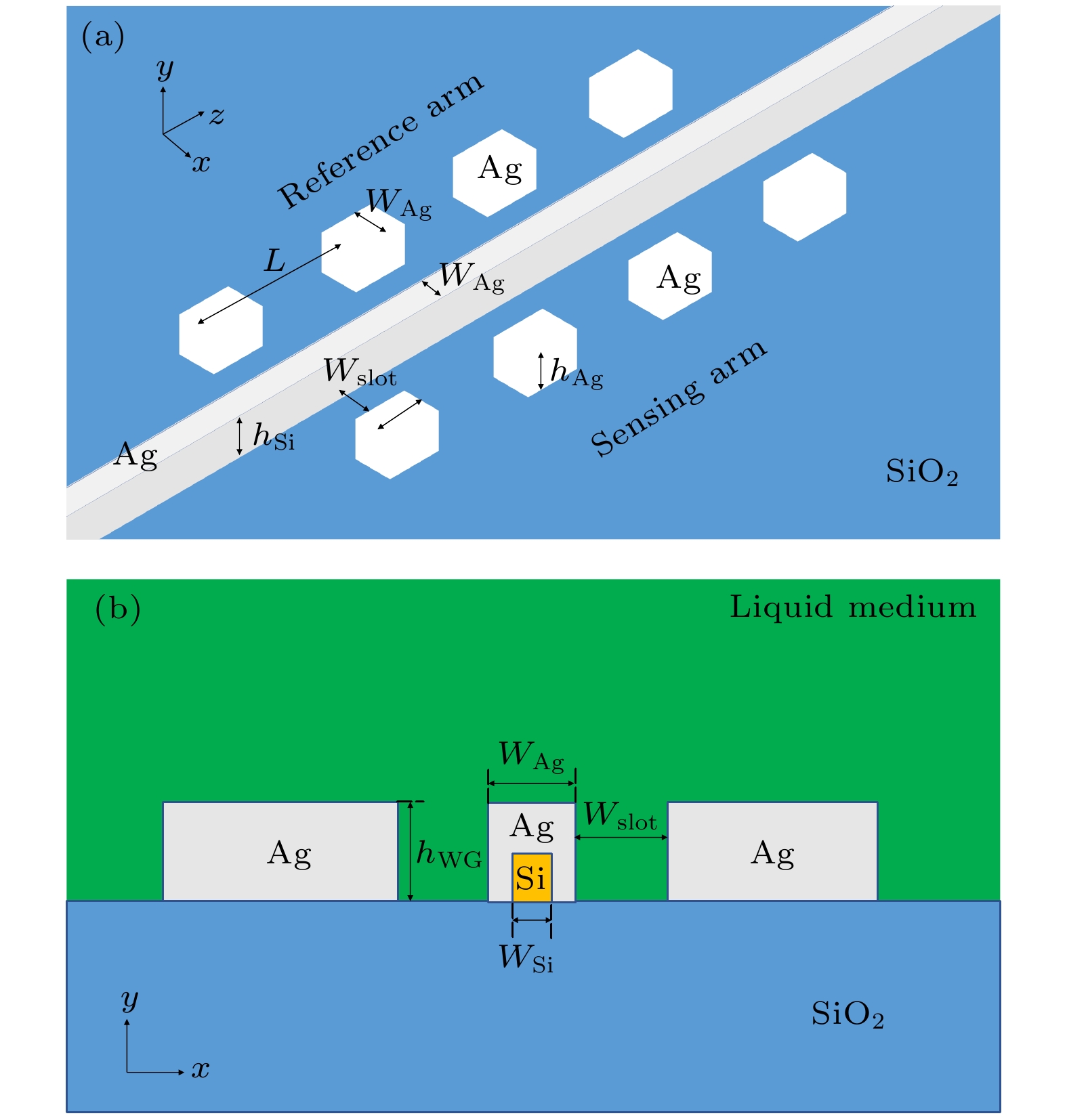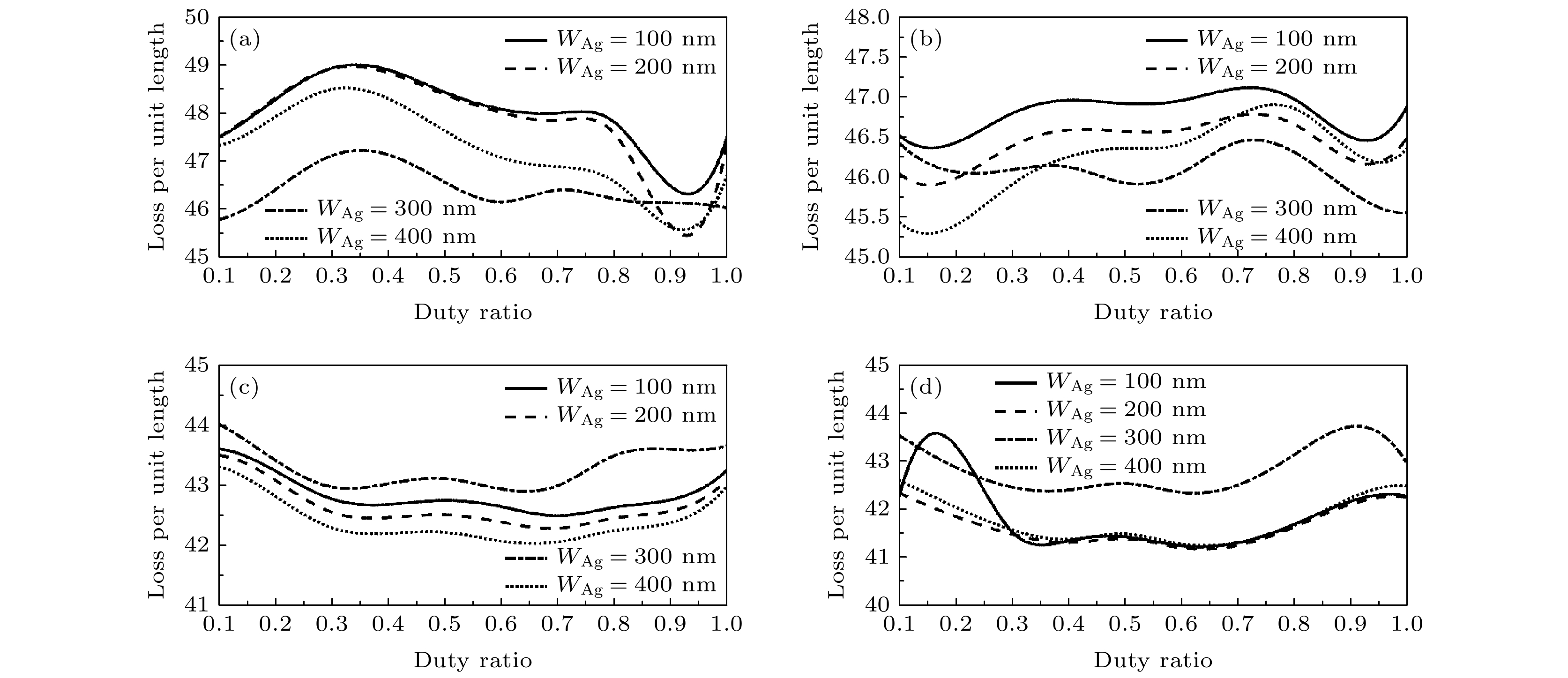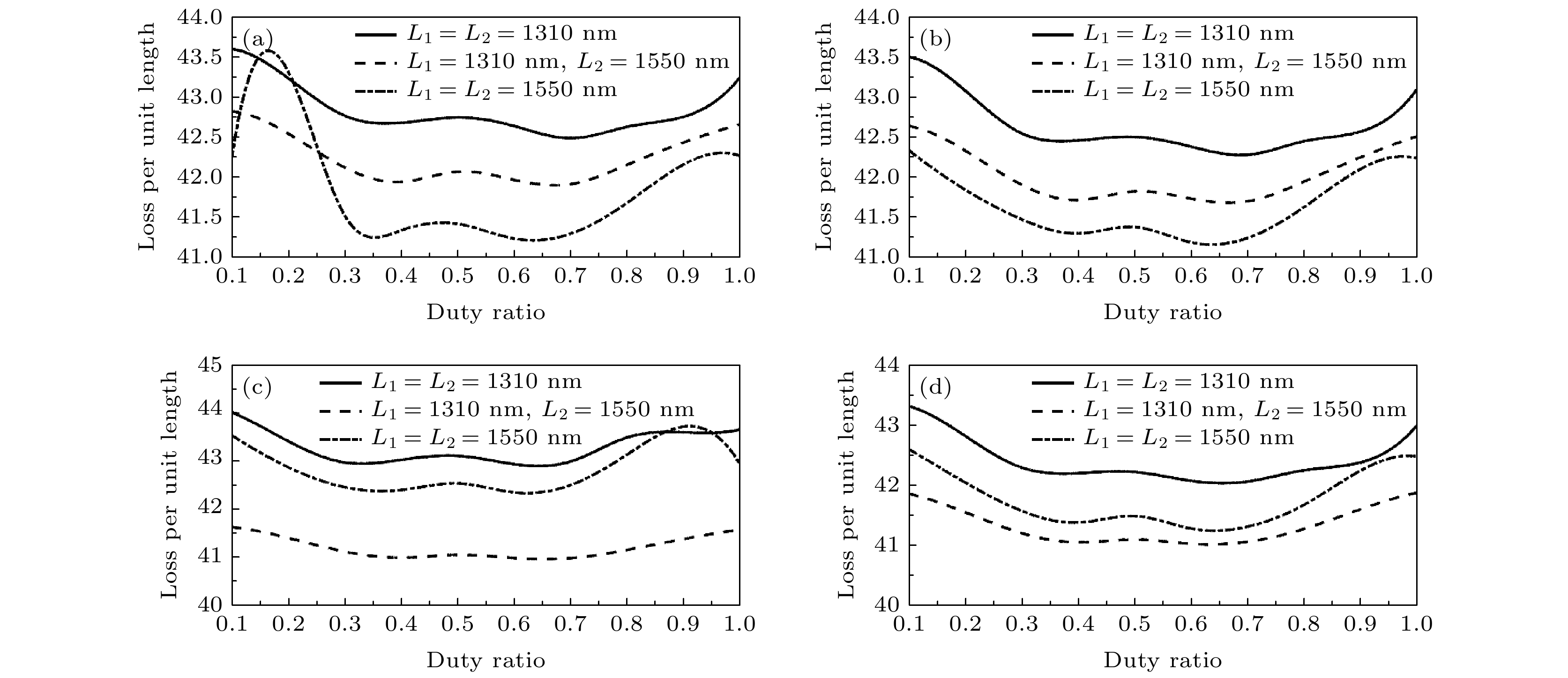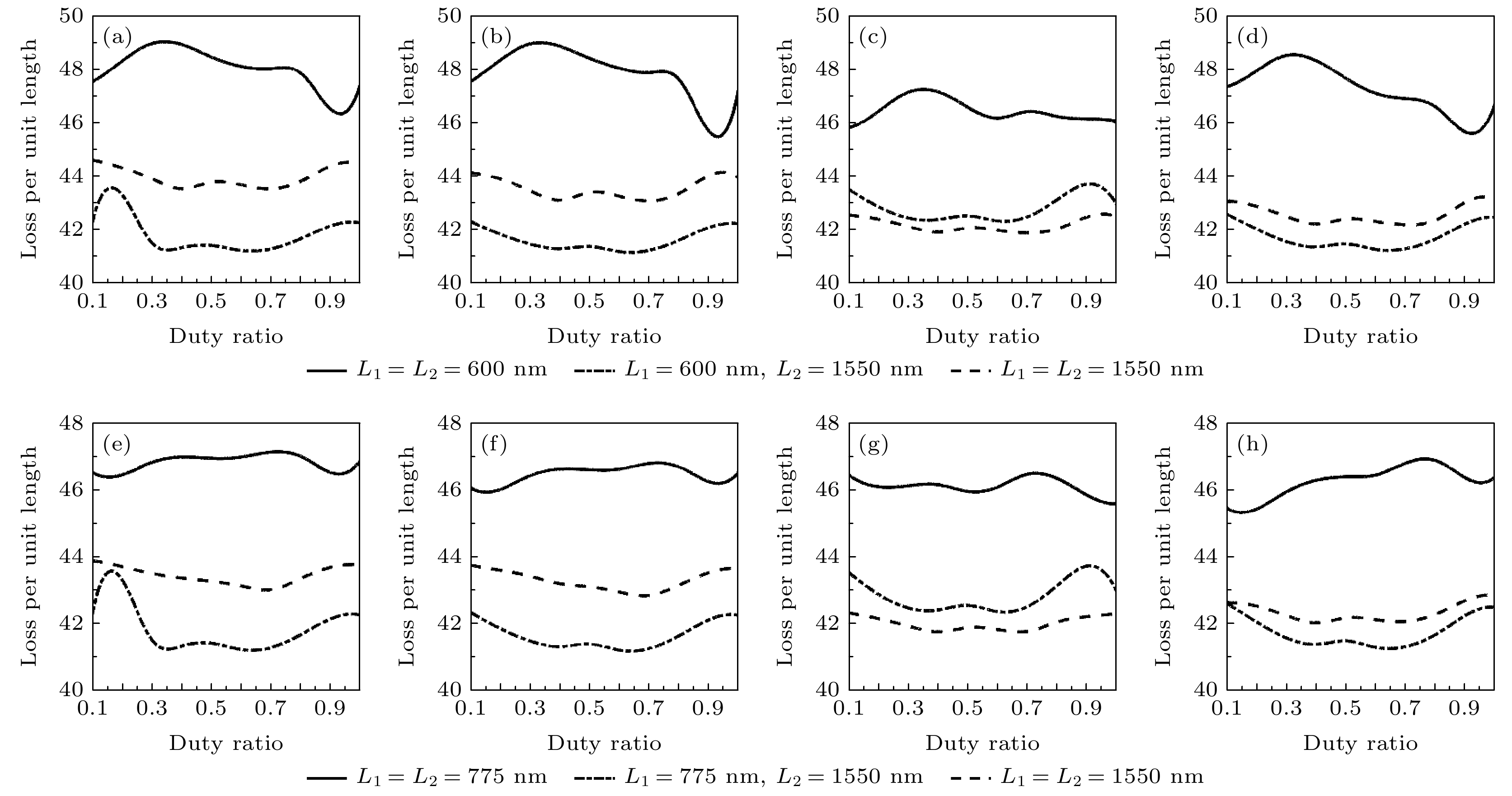-
In this paper, a Mach-Zehnder interferometric sensing structure based on silver nanochains of surface plasmons is optimized. The structure consists of a reference arm, a sensing arm and a nanowire waveguide. Nanowire waveguides are composed of silicon nanowires wrapped with a certain thickness of silver. Introduce two silver nanochains as the reference arm and the sensing arm of the Mach-Zehnder interferometer. And research the transmission characteristics of the designed structure. Improve the accuracy and sensitivity of the designed structure by reducing the transmission loss. Compared with two identical silver nanowires as the reference arm and the sensing arm. After the reference arm and the sensing arm are changed to silver nanochains, the transmission characteristics are significantly improved, and the loss per unit length is obviously reduced. This is because the long-range or coulomb interaction between the unit structures of the silver nano-chains enhances the electromagnetic field in the structure, thereby reducing the transmission loss. We set the lattice constants of the two silver nanochains to different situations. The study found that under the wider width of silicon-coated silver nanowires and certain duty ratios. The unit transmission loss of a structure containing asymmetric silver nanochains is smaller than that of a structure containing symmetric silver nanochains. It can be known that silver nanoparticle chains with small loss can compensate for the transmission loss of silver nanoparticle chains with large loss. Using this feature, we further optimized the design structure and changed one side of the silver nano-chain to nano-wire. Change the lattice constant and duty cycle of the silver nanochain on the other side. We have found that in most cases, this type of structure has better transmission characteristics than a structure containing two silver nanochains and a structure containing two silver nanowires. Our design structure can greatly reduce the transmission loss of the traditional Mach-Zehnder interferometer. Moreover, the fault tolerance rate is high in the preparation process of the structure. It has huge potential application value in practical application.
-
Keywords:
- sensor /
- SPPs /
- Mach-Zehnder interferometers
[1] Luan X G, Xu X M, Li M, Yu R, Cheng L F 2020 J. Alloys Compd. 850 156782
[2] Teng C X, Deng S J, Deng H C, Yang H Y, Xu Y H, Yuan L B, Zheng J, Liu H Q 2019 Opt. Eng. 58 072002
[3] Omair Z, Talukder M A 2019 Plasmonics 6
[4] Yamashita T, Ookawa N, Ishida M, Kanamori H, Sasaki H, Katayose Y, Yokoyama H 2016 Sci. Rep. 6 38552
 Google Scholar
Google Scholar
[5] Sepulveda B, Rio J S D, Moreno M, Blanco F J, Mayora K, Dominguez C, Lechuga L M 2006 J. Opt. A: Pure Appl. Opt. 8 S561
 Google Scholar
Google Scholar
[6] Ghosh S, Rahman B 2017 J. Lightwave Technol. 35 3003
[7] Ayoub A B, Ji D, Gan Q, Swillam, Mohamed A 2018 Opt. Commun. 427 219
[8] 刘仿, 李云翔, 黄翊东 2017 14 148101
 Google Scholar
Google Scholar
Liu F, Li Y X, Huang Y D 2017 Acta Phys. Sin. 14 148101
 Google Scholar
Google Scholar
[9] Ma Y Q, Nguyen-Huu N, Zhou J, Maeda H, Wu Q, Eldlio M, Pistora J, Cada M 2017 IEEE J. Sel. Top. Quantum 99 1
[10] Stefan A M 2007 Plasmonics-Fundamentals and Applications (London: Springer US) p45
[11] Hao J, Sabarinathan J 2010 Vestn Akad Med Nauk SSSR 114 38
[12] Mirzanejhad S, Ghadi A, Daraei M E 2018 Physica B 557 141
[13] Gan Q Q, Gao Y K, Bartoli F J 2009 Opt. Express 17 20747
 Google Scholar
Google Scholar
[14] Sun X, Dai D X, Lars T, Wosinski L 2015 Opt. Express 23 8
[15] Oulton R F, Sorger V J, Genov D A, Pile D F P, Zhang X 2008 Nat. Photonics 2 496
 Google Scholar
Google Scholar
[16] Chen C, Xun H, Jinhai S 2019 Opt. Express 25 31294
[17] Ghosh S, Rahman B M A 2019 Journal of Physics Conference Malacca, Malaysia, July 23–25, 2018 p012012
[18] Osowiecki G D, Barakat E, Naqavi A, Herzig H P 2014 Opt. Express 22 20871
[19] Liu W X, Yan J L, Shi Y C 2017 Opt. Express 25 31739
 Google Scholar
Google Scholar
[20] 李诗宇, 田剑锋, 杨晨, 左冠华, 张玉驰, 张天才 2018 23 234202
 Google Scholar
Google Scholar
Li S Y, Tian J F, Yang C, Zuo G H, Zhang Y C, Zhang T C 2018 Acta Phys. Sin. 23 234202
 Google Scholar
Google Scholar
[21] 程君妮 2018 67 024212
 Google Scholar
Google Scholar
Chen J N 2018 Acta Phys. Sin. 67 024212
 Google Scholar
Google Scholar
[22] Patel P B, Hamde S T 2017 J. Opt. 46 398
 Google Scholar
Google Scholar
[23] 王芳, 陈亚珂, 李传强, 马涛, 卢颖慧, 刘恒, 金婵 2021 70 224201
 Google Scholar
Google Scholar
Wang F, Cheng Y K, Li C Q, Ma T, Lu Y H, Liu H, Jin C 2021 Acta Phys. Sin. 70 224201
 Google Scholar
Google Scholar
[24] Shi Y C, Dai D X, He S L, Sun M 2006 CN1731149A (in Chinese)[时尧成, 戴道锌, 何赛灵, 孙淼 2006 CN1731149A]
[25] Liu N, Langguth L, Weiss T, Kstel J, Fleischhauer M, Pfau T, Giessen H 2009 Nat. Mater. 8 758
 Google Scholar
Google Scholar
[26] Hodgman C 1924 Handbook of Chemistry and Physics (Los Angeles: CRC Press) p22
[27] Aspnes D, EStudna A A 1983 Phys. Rev. B 27 985
 Google Scholar
Google Scholar
[28] Malitson I H 1965 J. Opt. Soc. Am 55 1205
 Google Scholar
Google Scholar
[29] Chen F, Zhang H F, Sun L H, L J J, Yu C C 2019 Opt. Laser Technol. 116 293
 Google Scholar
Google Scholar
[30] Stefan A M 2007 Plasmonics: Fundamentals and Applications (London: Springer US) p45
[31] Song G, Zhang W 2016 Plasmonics 12 1
-
图 2 波导宽度分别为
$W_{{\rm{Ag}}} = 100$ , 200, 300和400 nm, Ag纳米颗粒链晶格常数($ L_{1} = L_{2} $ )取不同值时, 单位长度低损耗和占空比之间的关系 (a) 600 nm; (b) 775 nm; (c) 1310 nm; (d) 1550 nmFigure 2. Loss per unit length versus duty ratio for four widths
$W_{{\rm{Ag}}} = 100$ , 200, 300 and 400 nm with different values of$L_{1} = L_{2} $ : (a) 600 nm; (b) 775 nm; (c) 1310 nm; (d) 1550 nm.图 3 非对称结构下, 包裹着Si纳米线的Ag纳米线宽度不同时单位长度的损耗与占空比之间的关系 (a)
$W_{{\rm{Ag}}}$ = 100 nm; (b) WAg = 200 nm; (c) WAg = 300 nm; (d) WAg = 400 nmFigure 3. Loss per unit length versus the duty ratio for the asymmetric structure with different width of Ag nanowire: (a)
$ W_{{\rm{Ag}}} $ = 100 nm; (b) WAg = 200 nm; (c) WAg = 300 nm; (d) WAg = 400 nm.图 4 非对称结构下, 包裹着Si纳米线的Ag纳米线宽度不同时单位长度的损耗与占空比之间的关系 (a), (e)
$ W_{{\rm{Ag}}} $ = 100 nm; (b), (f) WAg = 200 nm; (c), (g) WAg = 300 nm; (d), (h) WAg = 400 nm. 银纳米粒子链的晶格常数分别为 (a)−(d)$L_{1} = L_{2} = 600\;{\rm{ nm}}$ ,$L_{1} = 600\;{\rm{ nm}}$ ,$L_{2} = 1550\; {\rm{nm }}$ 和$L_{1} = L_{2} = 1550\; {\rm{nm }}$ ; (e)−(h)$L_{1} = L_{2} = 775\; {\rm{nm}}$ ,$L_{1} = 775\;{\rm{ nm}}$ ,$L_{2} = 1550\; {\rm{nm}}$ 和$L_{1} = L_{2} = $ $ 1550\; {\rm{nm}}$ Figure 4. Loss per unit length versus the duty ratio for the asymmetric structure with different width of Ag nanowire: (a), (e)
$ W_{{\rm{Ag}}} $ = 100 nm; (b), (f) WAg = 200 nm; (c), (g) WAg = 300 nm; (d), (h) WAg = 400 nm. The lattice constants of Ag nanoparticle chain are considered as: (a)−(d)$L_{1} = L_{2} = 775\; {\rm{nm}}$ ,$L_{1} = 775\; {\rm{nm}}$ ,$L_{2} = 1550\; {\rm{nm }}$ , and$L_{1} = L_{2} = 1550\; {\rm{nm}}$ ; (e)−(h)$L_{1} = L_{2} = 1310\; {\rm{nm}}$ ,$L_{1} = 1310\; {\rm{nm}}$ ,$L_{2} = 1550\;{\rm{ nm}}$ , and$L_{1} = L_{2} = 1550\; {\rm{nm}}$ .图 5 晶格常数L取不同值时,单位长度的损耗与占空比
$ r_{1} $ 之间的关系 (a) L = 600 nm; (b) L = 775 nm; (c) L = 1310 nm; (d) L = 1550 nm. 实线表示非对称结构, 虚线表示对称结构. 这里设置$ r_{2} $ 为1Figure 5. Loss per unit length
$\delta$ versus$r_{1}$ with different lattice constants: (a) L = 600 nm; (b) L = 775 nm; (c) L = 1310 nm; (d) L = 1550 nm. The solid line presents the the asymmetric structure and the dash line is the symmetric structure. Here,$r_{2}$ is fixed at 1 -
[1] Luan X G, Xu X M, Li M, Yu R, Cheng L F 2020 J. Alloys Compd. 850 156782
[2] Teng C X, Deng S J, Deng H C, Yang H Y, Xu Y H, Yuan L B, Zheng J, Liu H Q 2019 Opt. Eng. 58 072002
[3] Omair Z, Talukder M A 2019 Plasmonics 6
[4] Yamashita T, Ookawa N, Ishida M, Kanamori H, Sasaki H, Katayose Y, Yokoyama H 2016 Sci. Rep. 6 38552
 Google Scholar
Google Scholar
[5] Sepulveda B, Rio J S D, Moreno M, Blanco F J, Mayora K, Dominguez C, Lechuga L M 2006 J. Opt. A: Pure Appl. Opt. 8 S561
 Google Scholar
Google Scholar
[6] Ghosh S, Rahman B 2017 J. Lightwave Technol. 35 3003
[7] Ayoub A B, Ji D, Gan Q, Swillam, Mohamed A 2018 Opt. Commun. 427 219
[8] 刘仿, 李云翔, 黄翊东 2017 14 148101
 Google Scholar
Google Scholar
Liu F, Li Y X, Huang Y D 2017 Acta Phys. Sin. 14 148101
 Google Scholar
Google Scholar
[9] Ma Y Q, Nguyen-Huu N, Zhou J, Maeda H, Wu Q, Eldlio M, Pistora J, Cada M 2017 IEEE J. Sel. Top. Quantum 99 1
[10] Stefan A M 2007 Plasmonics-Fundamentals and Applications (London: Springer US) p45
[11] Hao J, Sabarinathan J 2010 Vestn Akad Med Nauk SSSR 114 38
[12] Mirzanejhad S, Ghadi A, Daraei M E 2018 Physica B 557 141
[13] Gan Q Q, Gao Y K, Bartoli F J 2009 Opt. Express 17 20747
 Google Scholar
Google Scholar
[14] Sun X, Dai D X, Lars T, Wosinski L 2015 Opt. Express 23 8
[15] Oulton R F, Sorger V J, Genov D A, Pile D F P, Zhang X 2008 Nat. Photonics 2 496
 Google Scholar
Google Scholar
[16] Chen C, Xun H, Jinhai S 2019 Opt. Express 25 31294
[17] Ghosh S, Rahman B M A 2019 Journal of Physics Conference Malacca, Malaysia, July 23–25, 2018 p012012
[18] Osowiecki G D, Barakat E, Naqavi A, Herzig H P 2014 Opt. Express 22 20871
[19] Liu W X, Yan J L, Shi Y C 2017 Opt. Express 25 31739
 Google Scholar
Google Scholar
[20] 李诗宇, 田剑锋, 杨晨, 左冠华, 张玉驰, 张天才 2018 23 234202
 Google Scholar
Google Scholar
Li S Y, Tian J F, Yang C, Zuo G H, Zhang Y C, Zhang T C 2018 Acta Phys. Sin. 23 234202
 Google Scholar
Google Scholar
[21] 程君妮 2018 67 024212
 Google Scholar
Google Scholar
Chen J N 2018 Acta Phys. Sin. 67 024212
 Google Scholar
Google Scholar
[22] Patel P B, Hamde S T 2017 J. Opt. 46 398
 Google Scholar
Google Scholar
[23] 王芳, 陈亚珂, 李传强, 马涛, 卢颖慧, 刘恒, 金婵 2021 70 224201
 Google Scholar
Google Scholar
Wang F, Cheng Y K, Li C Q, Ma T, Lu Y H, Liu H, Jin C 2021 Acta Phys. Sin. 70 224201
 Google Scholar
Google Scholar
[24] Shi Y C, Dai D X, He S L, Sun M 2006 CN1731149A (in Chinese)[时尧成, 戴道锌, 何赛灵, 孙淼 2006 CN1731149A]
[25] Liu N, Langguth L, Weiss T, Kstel J, Fleischhauer M, Pfau T, Giessen H 2009 Nat. Mater. 8 758
 Google Scholar
Google Scholar
[26] Hodgman C 1924 Handbook of Chemistry and Physics (Los Angeles: CRC Press) p22
[27] Aspnes D, EStudna A A 1983 Phys. Rev. B 27 985
 Google Scholar
Google Scholar
[28] Malitson I H 1965 J. Opt. Soc. Am 55 1205
 Google Scholar
Google Scholar
[29] Chen F, Zhang H F, Sun L H, L J J, Yu C C 2019 Opt. Laser Technol. 116 293
 Google Scholar
Google Scholar
[30] Stefan A M 2007 Plasmonics: Fundamentals and Applications (London: Springer US) p45
[31] Song G, Zhang W 2016 Plasmonics 12 1
Catalog
Metrics
- Abstract views: 5252
- PDF Downloads: 70
- Cited By: 0















 DownLoad:
DownLoad:


































